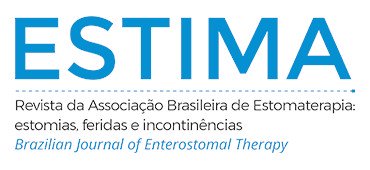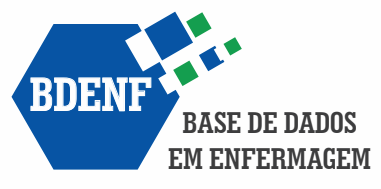Treatment of Localized Infections in Hard-to-Heal Wounds: An Integrative Review
Abstract
Objective: To identify the knowledge production on the treatment of localized infections in hard-to-heal wounds. Method: An integrative literature review was conducted in the Virtual Health Library, Nursing Database, Scientific Electronic Library Online, Web of Science, Cochrane Library, Catalog of Theses and Dissertations of the Coordination for the Improvement of Higher Education Personnel, and PubMed. The selected articles had no time limit. The studies were exported to the Rayyan application and subjected to double-blind evaluation through title and abstract reading, based on inclusion and exclusion criteria. The information was analyzed and synthesized according to the level of evidence. Results: A total of 19 publications were fully analyzed. The evidence obtained on the topic includes wound hygiene, cleaning with 1% acetic acid, identification and treatment of biofilms, the use of dressings, and solutions with antimicrobial action. Conclusion: Localized wound infections have been the subject of various research studies, and the recommended practices refer to topical treatments.
Downloads
Metrics
References
Murphy C, Atkin L, Swanson T, Tachi M, Tan YK, Ceniga MV, Weir D, Wolcott R, Ĉernohorská J, Ciprandi G, Dissemond J, James GA, Hurlow J, MartÍnez JLL, Mrozikiewicz-Rakowska B, Wilson P. Defying hard-to-heal wounds with an early antibiofilm intervention strategy: wound hygiene. J Wound Care 2020 Mar;29(Sup3b):S1-S26. https://doi.org/10.12968/jowc.2020.29.Sup3b.S1
Murphy C, Atkin L, Hurlow J, Swanson T, Ceniga MV. Wound hygiene survey: awareness, implementation, barriers and outcomes. J Wound Care 2021 Jul;30(7):582-90. https://doi.org/10.12968/jowc.2021.30.7.582
Silva ALDA, Matias LDM, Freitas JMS, Costa MML, Andrade LL. Predictive factors for worsening chronic wounds. Rev Rene 2020;21:e43615. https://doi.org/10.15253/2175-6783.20202143615
Moore MF. Prospective, descriptive study of critically colonized venous leg ulcers managed with silver containing absorbent dressings and compression. J Am Coll Clin Wound Spec. 2014 Sep;5(2):36-9. http://dx.doi.org/10.1016/j.jccw.2014.08.002
Falanga V, Isseroff RR, Soulika AM, Romanelli M, Margolis D, Kapp S, Granick M, Harding K. Chronic wounds. Nat Rev Dis Primers 2022 Jul;8(1):50. https://doi.org/10.1038/s41572-022-00377-3
Vyas KS, Wong LK. Detection of biofilm in wounds as an early indicator for risk for tissue infection and wound chronicity. Ann Plast Surg 2016 Jan;76(1):127-31. https://doi.org/10.1097/SAP.0000000000000440
Schultz G, Bjarnsholt T, James GA, Leaper DJ, McBain AJ, Malone M, Stoodley P, Swanson T, Tachi M, Wolcott RD; Global Wound Biofilm Expert Panel. Consensus guidelines for the identification and treatment of biofilms in chronic nonhealing wounds. Wound Repair Regen. 2017 Sep;25(5):744-57. https://doi.org/10.1111/wrr.12590
Galvão CM. Evidence hierarchies. Acta Paul Enferm. 2006;19(2):6. https://doi.org/10.1590/S0103-21002006000200001
Chang RYK, Morales S, Okamoto Y, Chan HK. Topical application of bacteriophages for treatment of wound infections. Transl Res. 2020 Jun;220:153-66. https://doi.org/10.1016/j.trsl.2020.03.010
Dissemond J, Dietlein M, Neßeler I, Funke L, Scheuermann O, Becker E, Thomassin L, Möller U, Bohbot S, Münter KC. Use of a TLC-Ag dressing on 2270 patients with wounds at risk or with signs of local infection: an observational study. J Wound Care. 2020 Mar;29(3):162-73. https://doi.org/10.12968/jowc.2020.29.3.162
Wei D, Zhu XM, Chen YY, Li XY, Chen YP, Liu HY, Zhang M. Chronic wound biofilms: diagnosis and therapeutic strategies. Chin Med J (Engl). 2019 Nov;132(22):2737-44. https://doi.org/10.1097/CM9.0000000000000523
Adis Medical Writers. Treat infected venous leg ulcers with appropriate culture-based antimicrobials and usual wound care. Drugs Ther Perspect. 2016;32:381-4. https://doi.org/10.1007/s40267-016-0325-2
Madhusudhan VL. Efficacy of 1% acetic acid in the treatment of chronic wounds infected with Pseudomonas aeruginosa: prospective randomised controlled clinical trial. Int Wound J 2016 Dec;13(6):1129-36. https://doi.org/10.1111/iwj.12428
Jeong HS, Lee BH, Lee HK, Kim HS, Moon MS, Suh IS. Negative pressure wound therapy of chronically infected wounds using 1% acetic acid irrigation. Arch Plast Surg. 2015 Jan;42(1):59-67. https://doi.org/10.5999/aps.2015.42.1.59
Lenselink E, Andriessen A. A cohort study on the efficacy of a polyhexanide-containing biocellulose dressing in the treatment of biofilms in wounds. J Wound Care. 2011 Nov;20(11):534, 536-9. https://doi.org/10.12968/jowc.2011.20.11.534
Cwajda-Białasik J, Mościcka P, Szewczyk MT. Antiseptics and antimicrobials for the treatment and management of chronic wounds: a systematic review of clinical trials. Postepy Dermatol Alergol. 2022 Feb;39(1):141-51. https://doi.org/10.5114/ada.2022.113807
Walker M, Metcalf D, Parsons D, Bowler P. A real-life clinical evaluation of a next-generation antimicrobial dressing on acute and chronic wounds. J Wound Care. 2015;24(1):11-22. https://doi.org/10.12968/jowc.2015.24.1.11
Percival SL, Vuotto C, Donelli G, Lipsky BA. Biofilms and wounds: an identification algorithm and potential treatment options. Adv Wound Care (New Rochelle). 2015 Jul;4(7):389-97. https://doi.org/10.1089/wound.2014.0574
Dalac S, Sigal L, Addala A, Chahim M, Faivre-Carrere C, Lemdjadi Z, Bohbot S. Clinical evaluation of a dressing with poly absorbent fibres and a silver matrix for managing chronic wounds at risk of infection: a non comparative trial. J Wound Care. 2016 Sep;25(9):531-8. https://doi.org/10.12968/jowc.2016.25.9.531
Hurlow J, Blanz E, Gaddy JA. Clinical investigation of biofilm in non-healing wounds by high resolution microscopy techniques. J Wound Care. 2016 Sep;25 Suppl 9(Suppl 9):S11-22. https://doi.org/10.12968/jowc.2016.25.Sup9.S11
Lipsky BA, Berendt AR, Deery HG, Embil JM, Joseph WS, Karchmer AW, LeFrock JL, Lew DP, Mader JT, Norden C, Tan JS; Infectious Diseases Society of America. Infectious Diseases Society of America. Diagnosis and treatment of diabetic foot infections. Plast Reconstr Surg. 2006;117(7 Suppl):212S-38S. https://doi.org/10.1097/01.prs.0000222737.09322.77
Jørgensen B, Bech-Thomsen N, Grenov B, Gottrup F. Effect of a new silver dressing on chronic venous leg ulcers with signs of critical colonisation. J Wound Care. 2006 Mar;15(3):97-100. https://doi.org/10.12968/jowc.2006.15.3.26876
Banu A, Sathyanarayana B, Chattannavar G. Efficacy of fresh Aloe vera gel against multi-drug resistant bacteria in infected leg ulcers. Australas Med J. 2012;5(6):305-9. https://doi.org/10.4066/AMJ.2012.1301
Jørgensen B, Price P, Andersen KE, Gottrup F, Bech-Thomsen N, Scanlon E, Kirsner R, Rheinen H, Roed-Petersen J, Romanelli M, Jemec G, Leaper DJ, Neumann MH, Veraart J, Coerper S, Agerslev RH, Bendz SH, Larsen JR, Gary Sibbald R. The silver-releasing foam dressing, Contreet Foam, promotes faster healing of critically colonised venous leg ulcers: a randomised, controlled trial. Int Wound J. 2005 Mar;2(1):64-73. https://doi.org/10.1111/j.1742-4801.2005.00084.x
Lipsky BA, Hoey C. Topical antimicrobial therapy for treating chronic wounds. Clin Infect Dis. 2009;49(10):1541-9. https://doi.org/10.1086/644732
Amirrah IN, Wee MFMR, Tabata Y, Idrus RBH, Nordin A, Fauzi MB. Antibacterial-integrated collagen wound dressing for diabetes-related foot ulcers: an evidence-based review of clinical studies. Polymers (Basel) 2020 Sep;12(9):2168. https://doi.org/10.3390/polym12092168
Swanson T, Ousey K, Haesler E, Bjarnsholt T, Carville K, Idensohn P, Kalan L, Keast DH, Larsen D, Percival S, Schultz G, Sussman G, Waters N, Weir D. IWII Wound Infection in Clinical Practice consensus document: 2022 update. J Wound Care. 2022 Dec;31(Sup12):S10-S21. https://doi.org/10.12968/jowc.2022.31.Sup12.S10
Downloads
Published
How to Cite
Issue
Section
License
Copyright (c) 2024 Letícia Maria de Oliveira, Larissa Carvalho de Castro, Olga Luísa Lucena, Daniel Nogueira Cortez, Sônia Regina Perez Evangelista Dantas, Juliano Teixeira Moraes

This work is licensed under a Creative Commons Attribution 4.0 International License.

























